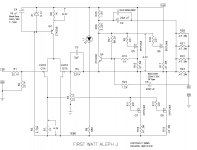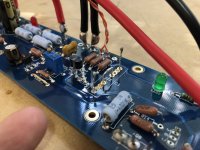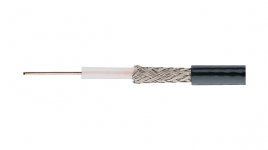I have experimented with the C1 capacitor. It think the quality of the capacitor is very important for the sound. I have tried the Jantzen superior Z which was very good. I liked Jupiter copper even better. Mundorf silver in oil did not quite suit my taste. I do not like the original Wima capacitor. it loose resolution and sound a bit narrow.
I have read that it's possible to use a wire instead for the c1. Is there anyone who can say something about it? Will there be a risk or could something go wrong?
I have read that it's possible to use a wire instead for the c1. Is there anyone who can say something about it? Will there be a risk or could something go wrong?
It will work, but the output DC offset tends to drift, so you want to keep an eye on it.
And your turn-on/turn-off thump might be a little bigger.
And your turn-on/turn-off thump might be a little bigger.
First of all, I'd like to express the gratitude to Mr Pass, for this lovely amp. The sound I am getting now, after a few minor modifications, is truly exceptional. I have excellent low-frequency definition, extension and grip, even with my Dynaudio's 4 ohms nominal impedance. Not to mention the sheer enveloping pleasure that combines the valves sound and the 2 gain stages solid-state control, while working in a true single-ended class-A mode of operation. Amazing blend.
I have attached a few photos. I removed the short circuit protection and the C1 capacitor. I also "tuned" the sound by playing with /adding few capacitors - I used Black Gates which I now very well how and where to use each type. If you look carefully at the power supply PCB, you'll notice a couple of add-ons red Black Gates 100uF/50V Nx non-polars - the bet sounding electrolyte ever made...
The benefits were stunning and explained in the top paragraph.
The turn on-off thump is actually less prominent.
Initial offset is around 250mV, which settles to within + and - 20mV (maximum!) after 10 minutes, and stays low... usually within plus and minus 7-8 mV only.
A few months back I moved to a fully differential config, which reduced the input loom ground buzz pickup entirely.
The sound is pure bliss. I have a lot of high-enders who came to listen to this marvel, and are begging me to "share the sound"... They say: "You can not keep this sound only for yourself, you have to share it..."
I suppose the biggest hazard is the potential for any DC signal to be amplified now, so - please make sure that there's no DC at the input.
Regards,
Nick
I have attached a few photos. I removed the short circuit protection and the C1 capacitor. I also "tuned" the sound by playing with /adding few capacitors - I used Black Gates which I now very well how and where to use each type. If you look carefully at the power supply PCB, you'll notice a couple of add-ons red Black Gates 100uF/50V Nx non-polars - the bet sounding electrolyte ever made...
The benefits were stunning and explained in the top paragraph.
The turn on-off thump is actually less prominent.
Initial offset is around 250mV, which settles to within + and - 20mV (maximum!) after 10 minutes, and stays low... usually within plus and minus 7-8 mV only.
A few months back I moved to a fully differential config, which reduced the input loom ground buzz pickup entirely.
The sound is pure bliss. I have a lot of high-enders who came to listen to this marvel, and are begging me to "share the sound"... They say: "You can not keep this sound only for yourself, you have to share it..."
I suppose the biggest hazard is the potential for any DC signal to be amplified now, so - please make sure that there's no DC at the input.
Regards,
Nick
Attachments
Last edited:
The sound is pure bliss. I have a lot of high-enders who came to listen to this marvel, and are begging me to "share the sound"... They say: "You can not keep this sound only for yourself, you have to share it..."
I suppose the biggest hazard is the potential for any DC signal to be amplified now, so - please make sure that there's no DC at the input.
Regards,
Nick
With your IE experience you definitely should try Aleph JX. 😀
No input capacitor. No DC on speaker terminals with or without DC servo.
Sound could be a bit different with SuSy. I like how Bob Ellis wrote about this.
Technically the X amps' loads see a push pull voltage, but I think of it as bridged single ended output stages.
Downside is serious heat. (sorry for Captain Obvious). 🙂
It will work, but the output DC offset tends to drift, so you want to keep an eye on it.
And your turn-on/turn-off thump might be a little bigger.
Thank you for your answer. I see that dc gets lower after a while. I use a TVC as a preamplifier. Will it provide better security when it's galvanic?
Initial offset is around 250mV, which settles to within + and - 20mV (maximum!) after 10 minutes, and stays low... usually within plus and minus 7-8 mV only.
A few months back I moved to a fully differential config, which reduced the input loom ground buzz pickup entirely.
Regards,
Nick
Hi, really nice amplifiers you have. I agree that these sound completely fantastic and after I removed c1 it even better.
Do you really mean that the bias should be set to 250mv? The manual says 400mv. How do you experience the difference?
I see that you have removed the minus input.
Mine is both balanced and unbalanced. When playing unbalanced, I use a jumper from ground to minus. If I not use this jumper it will be connected as yours, it is not correct? Then only plus and ground will be connected.
With your IE experience you definitely should try Aleph JX. 😀
No input capacitor. No DC on speaker terminals with or without DC servo.
Sound could be a bit different with SuSy. I like how Bob Ellis wrote about this.
Downside is serious heat. (sorry for Captain Obvious). 🙂
I have been eyeing that one for a while! The main problem is finding some spare time.
Hi, really nice amplifiers you have. I agree that these sound completely fantastic and after I removed c1 it even better.
Do you really mean that the bias should be set to 250mv? The manual says 400mv. How do you experience the difference?
I see that you have removed the minus input.
Mine is both balanced and unbalanced. When playing unbalanced, I use a jumper from ground to minus. If I not use this jumper it will be connected as yours, it is not correct? Then only plus and ground will be connected.
If you read my initial post again, you'll notice that I was not talking about the bias current (which I have set at 500mV, i.e. at around 1.1A🙂), but offset -> which is initially around 250mV when the amp is cold, and with the end-values being around 10mV after the amplifier (output MOSFET's) reach a stable temperature; usually around 5-10min.
There used to be a link between the ground and the - (minus) input, soldered underneath the amp PCB. This is why it's not visible on the photo. I have since moved to fully differential topology.
The TVC will prevent any DC being fed to the input, which is great in case you decide to keep C1 removed for good.
Thanks! I understand with DC offset. My amplifier is about 170mv when I turn it on and between 5-10mv when it gets hot.
What about bias? I thought the bias should be 400mv, but you adjust to 500mv. On youtube I see a video with someone who sets it to 450mv. What is the low/high limit for the bias, and how does the bias affect the sound.
What about bias? I thought the bias should be 400mv, but you adjust to 500mv. On youtube I see a video with someone who sets it to 450mv. What is the low/high limit for the bias, and how does the bias affect the sound.
I use DELUXE 5U ALUMINUM chassis, so pushing the bias a bit above 400mV is not a problem. The sound was more relaxed with a higher bias. I wouldn't worry too much about it...400mV is fine, especially if you do not have a lot of heartsink area to dissipate the heat.
First of all, I'd like to express the gratitude to Mr Pass, for this lovely amp. The sound I am getting now, after a few minor modifications, is truly exceptional. I have excellent low-frequency definition, extension and grip, even with my Dynaudio's 4 ohms nominal impedance. Not to mention the sheer enveloping pleasure that combines the valves sound and the 2 gain stages solid-state control, while working in a true single-ended class-A mode of operation. Amazing blend.
I have attached a few photos. I removed the short circuit protection and the C1 capacitor. I also "tuned" the sound by playing with /adding few capacitors - I used Black Gates which I now very well how and where to use each type. If you look carefully at the power supply PCB, you'll notice a couple of add-ons red Black Gates 100uF/50V Nx non-polars - the bet sounding electrolyte ever made...
The benefits were stunning and explained in the top paragraph.
The turn on-off thump is actually less prominent.
Initial offset is around 250mV, which settles to within + and - 20mV (maximum!) after 10 minutes, and stays low... usually within plus and minus 7-8 mV only.
A few months back I moved to a fully differential config, which reduced the input loom ground buzz pickup entirely.
The sound is pure bliss. I have a lot of high-enders who came to listen to this marvel, and are begging me to "share the sound"... They say: "You can not keep this sound only for yourself, you have to share it..."
I suppose the biggest hazard is the potential for any DC signal to be amplified now, so - please make sure that there's no DC at the input.
Regards,
Nick
Looking at C1 is that just a twisted pair woven through a few holes?. Thanks
Is there a minimum value for C1 that would still keep offset stable?
if you're asking for series cap on neg input, answer is simple
C=1/(2 x Pi x F x R)
shoot for few Hz max
R is Rin of neg leg, practically value of resistor in series with cap
This is perfect - thanks!!
So what minimum C1 capacitor value after yours mathematics ? 😉
- Home
- Amplifiers
- Pass Labs
- Aleph J C1



